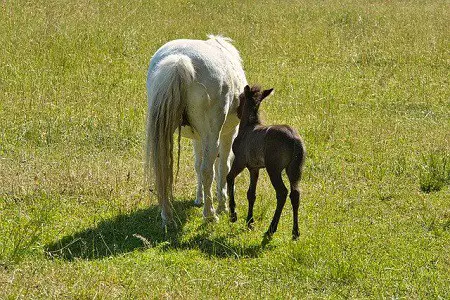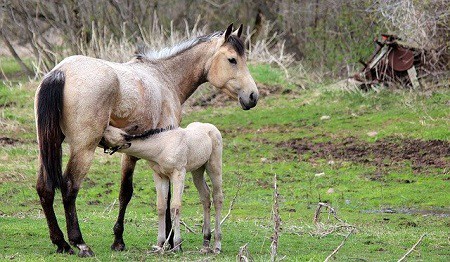Horses are a domesticated animal that is often used for transportation and work. It’s not uncommon to find them in the wild, but they are usually found on farms which provide them with food and shelter. Horses have been used as livestock since before written records began, so it’s no surprise that there is still much we don’t know about their lives. One thing you may not know about horses is their parenting style.
Do horses nurse their young? For the first three weeks, baby horses drink their mothers’ milk exclusively until they are old enough to eat grass as well. The milk of a mother horse is like liquid gold: the perfect mixture for growing healthy, strong foals. When there are no other mares around, a herd stallion will often step up as surrogate father and provide sustenance to his colts from time-to-time by regurgitating food into the baby’s mouth or even chewing hay before spitting it into the youngster’s mouth.
Newborn foals are usually so hungry they might suckle up to ten times a day in their first 24 hours. The colostrum that these babies ingest is what ensures proper health for the next 12-24 hours of life, as it contains antibodies and other important nutrients needed by horses in those critical early days.
How do horses grow and develop?
Foals are just like human babies in that they need to survive on their mother’s milk for a short period of time. This usually lasts about three weeks, and then the foal starts eating grass because it is healthy for horses’ digestive tracts. When a horse reaches out two or three months old, its mom will stop providing them with food—which means now’s when you get introduced to new foods such as grains!

Grass contains fiber which helps ensure digestion amongst other animals including horses; this is why you might have noticed them grazing in fields before we introduce different types of feeds into their diet-things like grain.
As they get older, the mother stops providing milk (much like human mothers who stop breast feeding) and the young ones are introduced to new foods such as grain which is made especially for them with nutrients necessary for growth and development.
Each baby horse has different growth plates on their bones, which helps them to grow and develop bones when they are young. When foals reach adulthood or stop growing, the cartilage fuse with the bone, turning into what we know as an adult’s bone.
A horse’s life changes drastically in its different stages. The foal is born, the yearling grows up and becomes a colt or filly- which they stay until adulthood when their gender changes back to male or female respectively-, then finally as an old horse where it suffers from arthritis and other age related diseases.
The process of understanding horses passes through four phases: birth, young animal (foal), adult animal with sexual maturity reached (yearlings) and elderly living creature that has aged considerably after reaching this stage by natural conditions associated mainly with arthritic problems caused by aging processes.
Key Facts About feeding Baby Horses
There are some key facts to know about feeding baby horses that can help make this transition easier for both horse and owner.
For starters, what is the best time of day to feed a young horse? Feeding a newborn foal in the morning may not always work because their stomachs are empty from fasting during gestation. This means there is less chance of colic than if fed later in the day when food has been resting for hours inside an empty stomach.
Other key facts –
- Foals drink milk from their mothers for the first few months of their lives
- The average weight of a baby horse is about 100 pounds
- A baby horse can walk within an hour after birth
- Baby horses have no teeth at birth and need to be fed with a diet of hay and oats until they develop them
- Horses grow up to be between 6-8 feet tall on average, but some breeds like Clydesdales can grow as high as 16 hands
- Horses are social animals that live in herds
- You can feed your horse by hand or with an automatic waterer
- A baby horse’s teeth will grow continuously throughout its life; this is why it needs to be fed soft foods like hay and oats
- When feeding a newborn foal, make sure the food isn’t too hot or cold
- Feeding baby horses is important for their development and growth
How do Baby Horses Nurse?
Foals will start off by licking over all of mom’s legs as well as her body in order to find that sweet treat – colostrum – which helps develop antibodies against infection while also providing essential nutrients like fat needed before weaning begins later on down the road!

Nursing is an important and vital part of owning a horse. After the birth, it’s best to get that foal on its feet as soon as possible so they can instinctually begin their nursing attempts by searching for the udder at both front and back where there are also two teats waiting eagerly for them.
Baby horses are actually born with an instinctive knowledge of how to eat grass. However, for the first few weeks after birth they may occasionally snack on dirt or other materials found in their environment that is not considered a mature horse’s food source.
This behavior should be monitored closely but does not require any special intervention from humans as it’s all part of the learning process and is simply a baby horse imitating its older family members.
Baby foals grow at an astonishing rate and can gain up to 3 pounds a day. I have been shocked by how quickly growing baby horses put on weight, so it’s important to monitor their habits if they’re not gaining enough.
Clogged milk ducts can become a serious problem in just weeks. Foals are born to be small and fragile, so they need those nutrients more than anyone.
If your horse has stopped feeding for more than 30 minutes consecutively or you notice the mother is having trouble producing milk due because her ducts are clogged, then contact your vet!

